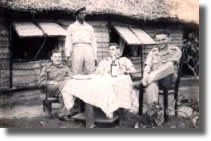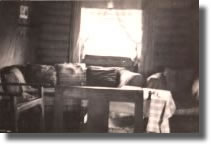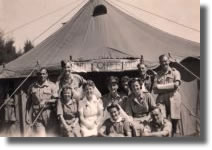C.S.M. Ernest William Fereday
Army Service No. 5334942
ERNEST WILLIAM FEREDAY
28TH MARCH 1916 - 24TH OCTOBER 1995
[LS74-1 & 3] Top row starting from
the left: a snapshot taken outside the W.O.'s and Sergeants Mess. Myself
sat on the left, next to me is the African Mess Waiter. Behind the bottle
is the Company Quartermaster Sergeant and next to him the Clerical Sergeant
out of the office.
Top, far right, is Sergeant Hague... a European who was with me, outside
what we called a Basha. The huts in which we lived made of reed and bamboo,
very dry and comfortable. No glass windows of course, just a shutter which
could be opened for ventilation. I had been promoted to Company Sergeant
Major at the time and he was one of my sergeants.
Below to the left is a Scotsman, mad as a hatter that chap. There is a
story I can tell you about that too. He was C.Q.M.S. - Company Quartermaster
Sergeant in charge of feeding and clothing the personal side of the troops.
Bottom right he is featured again with another sergeant and in the background
is one of the small Basha's. I had one of them on my own. On the back
of the photograph is the name Sergeant Griffiths but not too sure which
one the name belongs to...
Top right, elephants having their wash, the chap in charge of the had
a scrubbing brush and would take then down to the water and allow them
to spray themselves with their trunks. No doubt you would be familiar
with seeing this on television but it was new to us it was 1943, 40 years
ago. Then Ceylon was regarded as the 'British Jewel in the Crown of the
British Empire' or so they said on the newsreels, but they didn't record,
of course, THE SMELLS!!
During this period I unfortunately became ill and had to go into hospital
was No.1 British General Military Hospital in Colombo. I was there for
two months, anxiety neurosis they called it, mental trouble due to over
worry concentration and so forth.
However, while I was there, occupational therapy was the thing and I made
a wallet in real leather and still have it to this day. I still carry
it with me wherever I go. The Regimental Badge (China Dragon) and decoration
was done by myself.
Consequently, I was downgraded to B1 which wasn't that serious but it
meant that I wasn't in the front line, in other words it cut me from Burma
for which I wasn't sorry. It was nice to find a little job somewhere without
being in the front line. I am no hero, I don't admitting...
[LS74-7] 3rd row left: is my black counterpart, Sergeant Major. You can
see that he had been around a bit with all those medal ribbons. His name
was Gerigrio a very good chap. Next to him is a photo of an outside scene
of the camp, there are many Bash or bungalows built with reed and coconut
palms etc but as you can see there was also a tented area. These men featured
there are all ex-wounded or suffering from some complaint and were in
the process of returning to East Africa. Far left are three of my companions
on the grassy area in front of the beach at Mount Lavinia.
Bottom row left: Two personal servants employed and trained specially
and they fought in Burma. The one on the right was responsible for a Japanese
Officer. The middle photograph I took of the waves over the rocks where
I nearly lost my life. I had been out swimming and got caught in an undertow.
A very powerful currant swept my legs from under me and I had to work
very hard indeed to reach those rocks. Subsequently, I was smashed up
against them and suffered considerable grazes. Nothing serious, but I
was very sore for some days. Next, another view of the beach at Mount
Lavinia. You can see the railway runs along there.
1st Picture, top left is a view of the Hotel Mount Lavinia itself. This
was reserved for officers of all the Services, Navy, Army and Royal Air
Force. We chaps didn't get a look in and, of course, the WRENS were there
to keep them company!
[LS76-4] Bottom left is a photograph of a Japanese Soldier, he gave me
his collar which was adorned with his medal ribbons and badges but kept
the wristwatch for him. He was looked after by one of the servants on
the previous page.
[LS76-6] The small photograph is of me taken completely unawares by Clerical
Sergeant, he spoke my name, I looked up and he snapped me. I was trying
to type with reasonable efficiency with two fingers.
Next to that photograph is a picture of a girl in the paddy fields which
were near the camp, 8 miles from C.P.O...
On the end is a rather faded, under exposed photograph showing a group
of seven Europeans on a drinking session. The interesting point is that
the glasses were made out of beer bottles, which we filled halfway with
water, then poured some oil, a very small amount, then a red hot iron
was inserted into the bottle slowly which heated up the oil. The effect
was, the bottle was cracked all the way round evenly, then, by getting
the two glasses together, inserting them inside each other and grinding
them together, would smooth off the edges, inside and out.
2nd row is of a Destroyer. We were lucky enough to be invited aboard one
of these Destroyers to go out on an exercise, and when we went out, we
got a great shock because with the simulated active service all guns went
into action and when they did, it frightened the life out of us.
All the ducts were covered in plaster type stuff as actual crashing of
shells going off would send splinters all over the place. We were sent
down to the 'Mad Room' I think they called it 'control room' actually.
The lamps were swinging backwards and forwards with the firing of guns
and the conditions of the sea and everything else in fact we had got 'active
service' conditions and we found it very frightening and though those
chaps did a marvellous job on those destroyers, whenever they went into
action...
[LS78-6] 2nd row on the end is of a group that came from Leeds, the nurses
were in the Queen Alexander Royal Army Nursing Service. A couple of chaps
have their arms in plaster. They were all very keen Rugby Players and
unfortunately the ground they played on was very hard and very gravelly
and as a result there were several broken wrists.
Bottom row, me (Colonal Sergeant Major Fereday, K.A.R.) with hands on
hips with Sergeant Grey, R.W.A.F.F. and Private Jerome K.A.R., this was
taken Dec 1944 in Madras, India. I was responsible for getting these things
sorted out and suggested to the Commanding Officer to get some men, Blacks,
into uniform and act as Regimental Crime Police as a security point of
view so that they could sort any awkward black patients out. And there
were quite a few occasions when this needed to be done.
P 1 :: P
2 :: P 3 :: P
4 :: P 5 :: P
6 :: P 7 :: P
8 :: P 9 :: P
10

LS74-1

LS74-3

LS74-7

LS76-4

LS76-6

LS78-6
